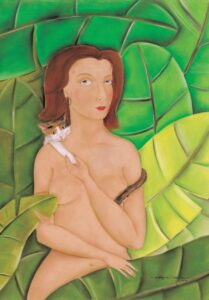
The Woman Portrayed 100 Times (ENA Y RAMI)
 By Zoé Valdés
By Zoé Valdés
They are two in one. She was his muse: Enaida Unzueta.The muse of the genius. A genius born to paint; and she to be painted by him, her brother: Ramón Unzueta. They are my friends, my accomplices, serene in eternity, portrayed by that same eternity in a drawing of sepia strokes in which she is an adolescent and he a boy sheltered in the hollow of her trembling hand.

Painting her, he became her. She was always very much he; that is why she understood him better than anyone else. As he understood her, when he dressed in her identity through his paintbrushes. Their complicity brought them together; it was a faithful complicity, vast, enduring; sometimes it became narrow and asphyxiating, like everything in life that is perfect. Nothing in them was imperfect. And besides, they knew to share that complicity with their best friends: I am one of them. Friend and sister, that is how I have always feltat the warmth of the sibling love of their friendship.Their parents were my own, my mother was also theirs. We learned to imitate each other in a symbiosis that was healthy, nourishing, elegant, respectful.

He turned her into an unusual woman that blends into the vegetation, the colored dress that envelops her penetrating the landscape, in the same mode that she emerges from another jungle landscape, so typical of Le Douanier Rousseau, the customs agent.He painted her as a child, as a girl and as a boy, an androgyny that served us both well; and that rekindled his artistic vigor, which was nothing more than the dual life. Her life in his; the girl and the boy that we have all been at some point, a sort of platonic being hovering towards the light.
He knew how to translate her and reinvent her, like a woman who reads and rereads sheltered by desire, a lover asleep with her desire, awake and hungry in her desire. The book slipping from her hands in a single stroke becomes the sheet wet with caresses; in the background, Havana, crowning the naked thighs, the translucent amphora body. It is all her, with that low-lidded gaze of the eyes turned towards the infinite and the cambrement that runs through her hair towards her back and the hindquarters of the mare in heat. He also admired that mare in heat, that savage that looks at us askance and runs us through with a dagger of honey; maybe he loved her more like this than as the brilliant young girl of the diaries written in a hand as slanted as her eyelids, or the one who took the volumes of José Martí on each trip, every time that she moved, all around the world.
He elongated her neck even more with two strokes of color: the white of the Geishas and the carnal dusty pink of the girl gangs of Havana. His gaze this time hung from the branch of a guava tree or rather of a cherry tree in bloom. But the red rose betrayed the passion from which she could never free herself, and the turmoil of the Basque in her.
In his paintings Enawent back to being the girl at the piano, with the bow and the bangs, and the pupils as sharp as the tips of a pencil. In the bow that knots her hair, the names of her loved ones, and the chiaroscuro reflections of an entire emotional trajectory holding them up in the tense back of a confused child.
He knew that she would always be there, in front of him, as she remains, inside of him.

She strove to protect him, to give him the merit, to take care of his work and his instincts. She was always his mother, in addition to their mother, from the moment he was born from the same uterus as she. And he, a wild child, came and went –she was also that permanent “voyage” needed by travelling artists who prefer to travel in their minds –as the brush comes and goes over a well-stretched canvas.
She was the Lee Krasner to his Jackson Pollock, the moon woman, poetry and power. She could do it all, can do it all, so that his work continues indelible in the pages of time. That is why he dedicated to her an enigmatic painting dedicated to “my Lee Krasner”.
He painted first for her –he always told me: “she decides”. Then he would do what he wanted, like the great painter that he was and she accepted, because he was the one in charge; the artist that she always respected and admired as much as she loved the brother, as much as she respects, admires and loves him.
Even when there were other subjects in his paintingsapart from her, he would also paint her, because he painted thinking of her, of the demand that she represented. Maybe that is why he once called her in a letter on one of her birthdays: “The woman portrayed 100 times”. More than one hundred times, she palpitates with her intelligence, her critical sagacity, in all of Unzueta’s work. They are both the force of truth, of the authenticity that is the history of two mysteries in one: art and its immortality.